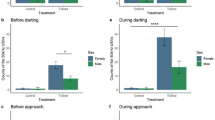Abstract
ULTRASONIC vocalisations commonly occur during social interactions among rodents. During mating, adult male and female rats (Rattus norvegicus) emit brief 50–60 kHz ultrasonic calls1; however, the function of these vocalisations is not known. In this study, we demonstrate that these mating calls have a precise function for communication. Specifically, 50-kHz vocalisations elicit sexual activity in female rats. Female rats exhibit a series of solicitation patterns during sexual behaviour, including orientation, darting and ear wiggling. These movements excite the male and enhance the likelihood of mounting, thereby facilitating copulation2–4. (Beach has emphasised the importance of solicitation by the female during mating and has suggested the term ‘proceptivity’ to include the female's behaviour in the initiation and maintenance of copulation.) Although the presence of an intact male is usually a prerequisite for solicitation behaviour, the specific sensory cues which elicit it are not known. Isolated oestrous female rats exposed to ultrasonic vocalisations from a male exhibited a shorter latency to, and higher rate of darting when subsequently placed in a mating situation5. Although the auditory cues primed oestrous females to display increased solicitation behaviour when later confronted with an intact male, there was no indication that these ultrasonic vocalisations had a direct function for communication in the induction of these behaviour patterns. The objective of the present report was to determine if ultrasonic mating calls of rats have a direct function for communication during copulation.
This is a preview of subscription content, access via your institution
Access options
Subscribe to this journal
Receive 51 print issues and online access
$199.00 per year
only $3.90 per issue
Buy this article
- Purchase on Springer Link
- Instant access to full article PDF
Prices may be subject to local taxes which are calculated during checkout
Similar content being viewed by others
References
Sales, G. D. Anim. Behav. 20, 88–100 (1972).
Hlinak, Z. & Madlafousek, J. Physiologica Bohemoslovaca 23, 146–147 (1974).
McClintock, M. K., thesis, Univ. Pennsylvania (1974).
Beach, F. A. Horm. Behav. 7, 105–138 (1976).
Geyer, L. A., McIntosh, T. K. & Barfield, R. J. J. comp. Physiol. Psychol. (1978).
Bruning, J. L. & Kintz, B. L. Computational Handbook of Statistics (Scott Foresman, Glenview, Illinois, 1977).
Diakow, C. J. comp. physiol. Psychol. 88, 704–712 (1975).
Kow, L. M. & Pfaff, D. W. Horm. Behav. 6, 259–276 (1975).
Pfaff, D. & Lewis, C. Horm. Behav. 5, 317–335 (1974).
Pfaff, D., Lewis, C., Diakow, C. & Keiner, M. in Progress in Physiological Psychology 1 (eds Stellar, E. & Sprague, J.) (Academic, New York, 1972).
Floody, O. R. & Pfaff, D. W. J. comp. physiol. Psychol. 91, 820–830 (1977).
Beach, F. A., Stern, B., Carmichael, M. & Ranson, E. Behav. Biol. 18, 473–487 (1976).
Whitney, G., Alpern, M., Dizinno, G. & Horowitz, G. Anim. Learning Behav. 2, 13–18 (1974).
Geyer, L. A. & Barfield, R. J. J. comp. physiol. Psychol. (1978).
Geyer, L. A., Barfield, R. J. & McIntosh, T. K. J. comp. physiol. Psychol. (1978).
Adler, N. J. Eastern Conference on Reproduction Behavior, Skidmore College, Saratoga Springs, New York, 13–16 June, 1976.
Barfield, R. J. & Geyer, L. A. Science 176, 1349–1350 (1972).
Francis, R. L. Nature 265, 236–238 (1977).
Sales, G. D. J. Zool. 168, 149–164 (1972).
Lore, R., Flannelly, K. & Farina, P. Aggr. Behav. 2, 175–181 (1976).
Author information
Authors and Affiliations
Rights and permissions
About this article
Cite this article
MCINTOSH, T., BARFIELD, R. & GEYER, L. Ultrasonic vocalisations facilitate sexual behaviour of female rats. Nature 272, 163–164 (1978). https://doi.org/10.1038/272163a0
Received:
Accepted:
Issue Date:
DOI: https://doi.org/10.1038/272163a0
This article is cited by
-
Two genetic loci control syllable sequences of ultrasonic courtship vocalizations in inbred mice
BMC Neuroscience (2011)
-
Vocal and visual stimuli enabling copulation behavior in female buntings
Behavioral Ecology and Sociobiology (1988)
Comments
By submitting a comment you agree to abide by our Terms and Community Guidelines. If you find something abusive or that does not comply with our terms or guidelines please flag it as inappropriate.



